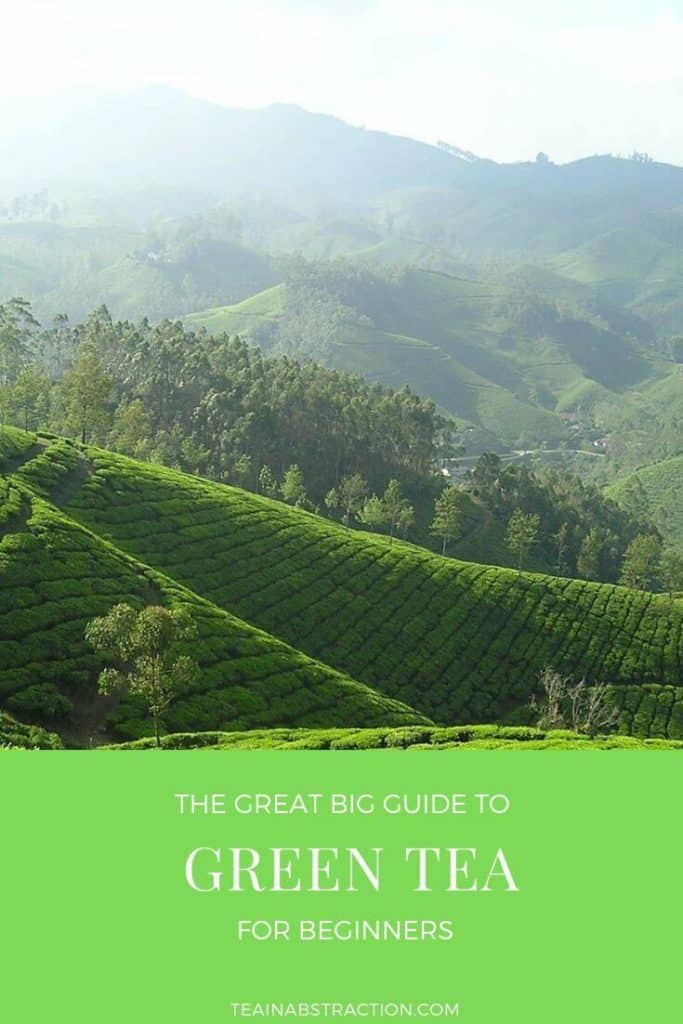*This Article May Contain Affiliate Links* See our Affiliate Disclosure for more Info
If you are looking for a guide to green tea you have come to the right place. The goal here is simple. Give you a brief look at some of the most popular types of green tea that I can find.
It might be a long road, so strap in and grab a cup of your favorite green tea, here are some of mine. Let’s get started.
Green tea is one of the most popular drinks on the planet. It still trails black tea in overall popularity but it holds huge mindshare among the health conscious.
The thing is, green tea is one thing. There are dozens of types of green tea from a wide range of countries and regions.
From Japan to India to China and beyond. A variation of green tea can be found in almost every tea growing region on earth.
I will be taking a look at most of them. I would say all of them but I will probably miss one or two. Worry not they will be added as soon as I can research them a bit.
So welcome to the Great Big Green Tea Guide. It is a long read but I think it will be worth it. I hope you enjoy it.
These teas are in no particular order. It just seemed like it would be more fun than dropping them in alphabetically. Now you don’t know whats coming next.
Plus it makes it easier to edit in new ones without having to reformat the entire article. Thanks for understanding.
Enjoy.
Sencha Green Tea
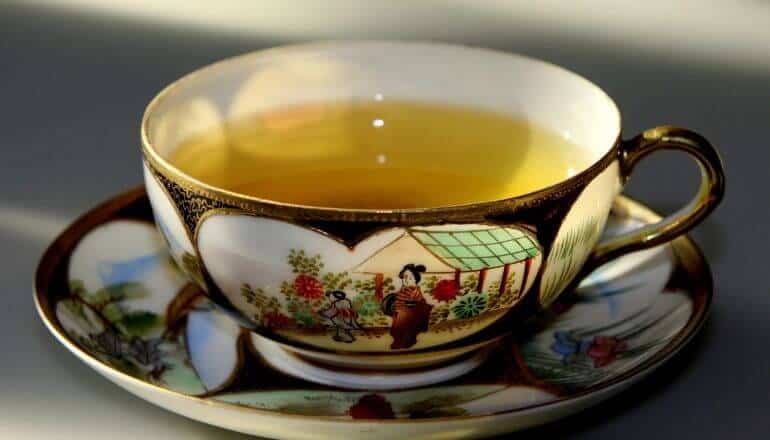
Sencha green tea is one of the most popular and abundant green teas available. It is the number one green tea in its native Japan and has spread around the world delighted millions each day.
It is a delicate green tea that is steamed and rolled to lock in the flavor and anti-oxidants. Chances are when you order a Japanese green tea you are going to get a Sencha unless you specify otherwise.
Sencha is from China originally. It was brought to Japan sometime during the 17th century, according to this article. It was in Japan that the tea would really take off.
It is beloved in Japan comprising about 80% of the green tea grown in the country. There are a few types of Sencha.
These are typically differentiated by the way the leaves are picked and processed. But they all fall under the Sencha umbrella. Try them all and see which one you like the best.
The Taste Of Sencha Green Tea
Sencha Green Tea has a delicate grassy aroma to it. The smell is delightful and reminds me of a crisp damp morning. A very Aromatic tea.
The taste follows down the same path. It has a distict but subtle vegetable flavor to it. It is crisp and slightly sweet when properly brewed.
Check out the below steeping instructions but keep in mind these are just the averages. You’ll need to test each brand of Sencha to find the sweet spot.
Time And Temp For Sencha
1.5 minutes
Don’t over steep your Sencha.
75°C
Watch the Temp carefully. Sencha Is Delicate
1 Gram
Use about 1 gram of Sencha Loose Leaf Tea
The Finish
A quick run down of one of the most popular and most enjoyable green teas you can find. This is what I would call the most mainstream green tea that aren’t you mass market grocery store teas. That doesn’t mean it is bad.
Quite the opposite. It is a fantastic green tea and one suitable for all types of green tea drinkers. I love this Sencha from Buddha Tea. I think you will enjoy it as much as I do.
Genmaicha Green Tea
Genmaicha is another fantastic green tea from Japan. This is easily one of my favorite green teas out of anything on this list.
What makes this green tea so special is that it has popped roasted brown rice kernels mixed in with the tea leaves. It is a unique and interesting green tea.
As mentioned this tea is from Japan. It was born out of necessity really. Green tea was often a very expensive beverage in years past.
Therefore in order to make tea last longer the middle class and lower class people would mix in the roasted rice with their tea leaves to extend the life of a bag of tea.
Today, however, this tea is enjoyed across all social and economic levels. It was originally nicknamed The People’s tea and it’s since become one of the most beloved teas in Japan and around the world.
The Flavor And The Aroma Genmaicha Green Tea
As you would expect, the smell of the Genmaicha is a combination of the grassy notes from the green tea leaves and the sharper roasted tones from the rice. The rice, in fact, gives it an almost popcorn-like smell.
The Flavor of the tea follows a similar pattern. There is a distinct vegetable and grassy note that is smooth when you drink the green tea but there’s also the salty, roasted, nutty flavor of the roasted brown rice.
It combines to create one of the most fantastic flavors you’re ever going to find in a tea. Buddha Teas Has one of my favorite examples of Genmaicha, which you can check out right here.
Genmaicha Time and Temp
1.5 Minutes
Oversteeping will cause your Tea to be bitter, ruining the Genmaicha
80°-90°C
The temperature is based on what type of green tea is used as the base
2 Grams
Genmaicha requires a little bit more tea leaves for a proper brew
The Finish
The people tea may have come from humble beginnings but it turned into one of the most enjoyable green teas that you could possible find these days.
They say necessity is the mother of all invention. They did a mother of a job when they created this little gem out of necessity.
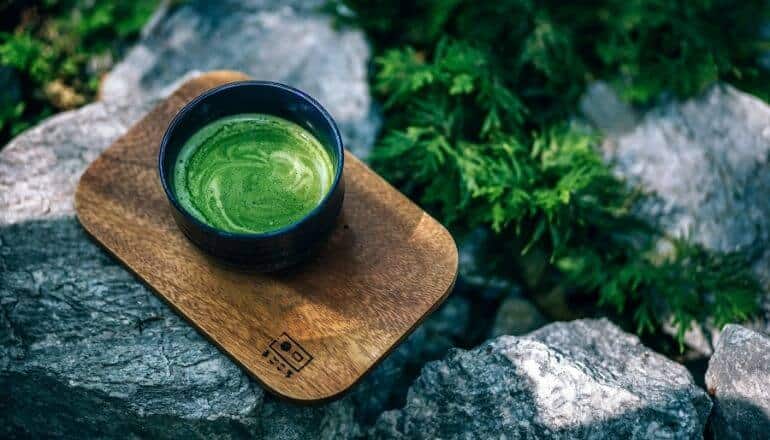
Matcha Green Tea
Matcha is a powdered green tea from Japan that has exploded in popularity over recent years. Especially in the west. Traditionally it is used as a ceremonial tea in Japan.
These days, however, it has become famous for its health benefits and has worked its way into all types of foods. From smoothies to baked goods. The best way to enjoy it however is the old fashioned way. In a cup.
Matche green tea leaves are grown in a couple regions in Japan. The Uji and Nishio regions specifically, according to Pure Leaf Teas. It is shade grown which helps contribute to its vibrant green color.
China has started to produce its own version of Matcha. It tends to be cheaper than its Japanese counterpart. While good by itself, the Chinese tea is not a full substitute for the classic Japanese Matcha.
Taste and Aroma of Matcha Green Tea
Matcha should have a fresh vegetable aroma to it. Always make sure to give it a whiff before brewing it to make sure you have some good matcha powder.
I always think of a good matcha smell as something like freshly cut green vegetables. Not too strong but enough to get a distinct aroma.
A good matcha should have a creamy smooth texture and the grassy, vegetable notes should be the most prominent. It should also have a bit of natural sweetness to it.
Overall it is a very complex flavor. One of my favorite matcha green teas can be found at Buddha Teas. I think you will be quite satisfied with it.
You might see some people claim that their matcha has a fishy taste to it. Typically this means that your powder has picked up some outside aromas. Matcha must be stored properly in a sealed container to avoid this type of thing.
Time And Temp For Matcha Green Tea
Until Dissolved
Matcha is a powder so just whisk it for a few minutes until it froths
80°C
Don’t go higher than this Temperature. A little Lower is fine
~1 Tablespoon
Measure a heaping tablespoon of this verdant delight
The Finish
It might seem like a novel idea at this point, but you can drink matcha green tea just for the taste. Just because you like it. It doesn’t need to be part of some cleanse or detox.
It doesn’t need to be added to every smoothie or fruit drink. You don’t need to throw ginger or lavender into it just to make it taste good.
No matcha is wonderful by itself. Some water, some beautiful green powder and a bamboo whisk and you have yourself a great, refreshing drink to enjoy.
Gyokuro Green Tea
Gyokuro is a Japanese shaded green tea. By growing it outside of direct sunlight and covering the growing leaves for a few weeks the Gyokuro takes on its distinct aroma and flavor notes.
The best Gyokuro comes from the Yame region in Japan, the Yamecha Gyokuro is renowned for its unrivaled quality.
Gyokuro is also one of the most expensive types of Japanese green tea. There is a range of quality among this tea.
The very high-quality Gyokuro has a much better taste than some of the lower quality leaves. Be careful when choosing your preferred brand
Taste and Aroma of Gyokuro Green Tea
The smell of a good Gyokuro can be a bit off putting if you don’t know what to expect from it. It typically has a very strong grassy smell associated with it.
A pile of freshly cut wet grass is one way I have heard it described. Add in a slight seaweed smell and you have a complex aroma for this great green tea.
The taste follows along the same patch. It has a grassy taste but is only slightly sweet. The umami, or savory, taste of the tea is typically the strongest note for a Gyokuro.
Give this Gyokuro from a try.
Brewing Instructions For Gyokuro Green Tea
2 minutes
An even 2 minute steep is the sweet spot for the green tea.
40°C to 60°C
Keep the temperature low. This is the Max temp. Go lower if you want.
3-4 Grams
This will make a nice sized cup of Gyokuro Green tea to enjoy.
The Finish
One of the more expensive green teas. And worth every penny. This delicate tea must be prepared and brewed properly to get the most out of it and unleash the complex flavors that are stored in these pricey leaves.
I would recommend waiting a little while before trying Gyokuro if you are new to green tea. It can be an eye opening experience and it does turn some people off with its rich flavor.
Its price can be a little prohibitive for some people as well.. Check it out when you think you are ready for it.
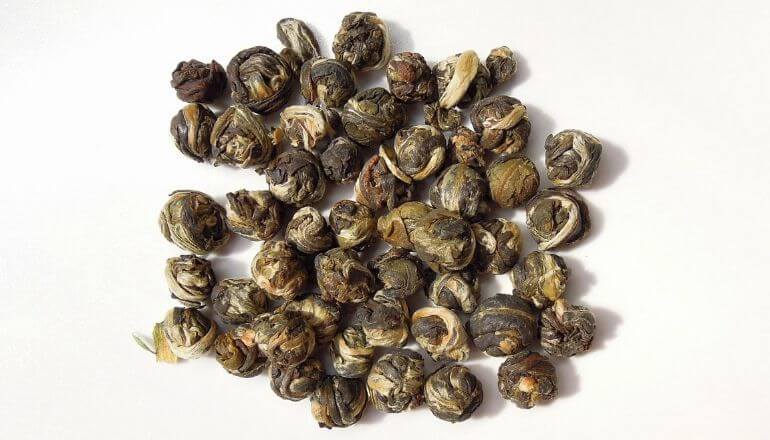
Gunpowder Green Tea
Gunpowder green tea has its roots in China where it is known as pearl tea. There are a few different types of gunpowder tea. A variant is even grown in Sri Lanka, called Ceylon Gunpowder. Other types of tea, particularily Oolong, can be found in gunpowder form.
The tea gets its name form the shape it is rolled into. It looks like a little ball. In the west it is called gunpowder tea because of this.
China is the region that this tea orginated in. But is has grown to be a worldwide commodity. China itself produces a variety of gunpowder teas. A couple of the green tea types that are rolled into gunpowder styles are Chun Mee and Dong Ding.
Taste and Aroma of Gunpowder Green Tea
Gunpowder green tea has a somewhat smoky flavor to it. This can be of putting to someone who is trying it for the first time.
To some people it can seem like they are drinking a cigar because f the smoky tones. Chances are they have never smoked a cigar but that is the impression that they get.
The taste is typically stronger than many other green teas, possibly due to how tightly the leaves are rolled to lock in the flavor. Teavivre has a great example of a Chinese gunpowder green tea.
The aroma is a little smoky as well, but there are distinct sweet almost fruit notes for the Chinese varieties of this green tea.
Time And Temp For Gunpowder Green Tea
2-3 minutes
Try and keep the time under 2.5 minutes and almost always under 5.
70°c to 80°C
The lower the better with gunpowder green tea. Aim for 75 or below.
1 Teaspoon
Use 1 teaspoon for every 5-6 oz of water you use. Makes for a great cup.
The Finish
Gunpowder green tea is not for everyone. It’s smoky taste can be off putting to a new drinker and you will probably need some time to adjust to it.
It also has a bit more caffeine that most other green teas. Once you really get a taste for this outstanding green tea, however, you will wonder why you ever went without it.
Bancha Green Tea
Bancha is a popular daily green tea from Japan. It is often considered the lowest grade of Japanese green tea.
The tea leaves used for Bancha are picked later in the season. Even though they are form the same tea trees as Sencha it is considered a lower grade due to the time when it is harvested.
Bancha is grown in the same regions as much of the Sencha teas. Since it is harvested after Sencha the older leaves lower down on the tree make up the bulk of the Bancha tea leaves.
This is one of the major reasons why it is considered a lower grade green tea than Sencha.
Taste and Aroma of Bancha Green Tea
Bancha has a very strong straw smell associated with it. It still has an air of grass about it but it seems drier than many of its other green tea counterparts.
It has a very unique taste among green teas. It has less grassy notes than most other green teas and, in my opinion, less overall flavor.
But it is still a very good green tea to drink and one that you can have daily and for any occasion really. One of the best Bancha Green Teas can be found at Amazon.
Time And Temp For Bancha Green Tea
1 minute
Similar to Sencha this tea only need about a minute for the first steep
80°C
This green tea is not as delicate and preforms well at these temperatures
1 Teaspoon
One teaspoon should give you a nice balanced cup of Bancha Green Tea
The Finish
Often dismissed as a cheap green tea that pales when compared to the like of other Japanese teas, Bancha is actually a very refreshing green tea that you can afford to drink everyday without breaking the bank.
Is it as robust as Gyokuro? Of course not. But don’t let that dissuade you from trying this wonderful green tea.
Kukicha Green Tea
Kukicha Green Tea is one of the wonders of Japan. Mostly produced in the Shizuoka prefecture, the ‘name’ of this type of tea may vary if produced in other Japanese regions or if its plant of origin is grown in a particular way.
Made mainly from 3 years old non-roasted Sencha’s green tea stems, stalks, and twigs; this beverage has unique characteristics that separate it from other types of teas, even the Sencha.
Because this tea doesn’t have any leaves – or it contains just a minimum of them -, its caffeine levels are dramatically lower than those found on regular green tea. In the same fashion, its pale green or light yellow color sets it apart from other green teas.
Also, the stems and stalks it is made from, give this infusion a ‘cloudy’ look instead of a bright tone present in most teas. Adagio Teas has a very nice Kukicha Green Tea for you to consider.
Taste and Aroma of Kukicha Green Tea
Kukicha Green Tea is very popular due to its ‘easygoing’ aroma and flavor. Most people describe this tea smell as fresh and very vegetable.
When it comes to its flavor, things can get very interesting: even though it has a grass-like and sweet-fresh taste; after it is drunk, it leaves a dry and full feeling on the tongue with some bitter tones after swallowed.
Kukicha Time And Temp
2 minutes
2 minutes is the perfect time to steep your Kukicha Green Tea.
70°C
Keep the temperature down in the low 70’s to get a great cup of tea.
2 Grams
A couple of grams is just enough to make the perfect cup.
The Finish
Although Kukicha Green Tea is mostly drunk hot, during summer time some people prefer to drink it with ice and even mixed with juice to prepare a child’s drink.
Hojicha Green Tea
Hojicha is a roasted tea which was first planted in Kyoto in Japan. It comes from the same plant as the other green teas but how it is made makes it different. Hojicha tea has some elements which include theanine, tannin, vitamin c, and caffeine.
Hojicha can be made from whole leaves or pieces of stems,veins, and leaves. When making Hojicha you start with green tea which is steamed to bring oxidation to a stop. Leaves are then put in a drum that is rotating and roasted to about 200°C and cooled.
This process of roasting sets off chemical changes that reduce the caffeine level in the tea leaves.
Hojicha regardless of its base tea it has a little bitterness and low caffeine. Catechins too account for bitterness in tea together with the infusion color.
Hojicha has a color of reddish brown. Its hue varies on harvest date or on what has made it, either Banca, Sencha or kukicha.
Hojicha has 0.13 grams of caffeine in 100 grams which makes it suitable to be enjoyed later in a day. Hojicha is made by roasting rolled dried leaves of tea, stems or twigs producing loose tea leaf.it can be grounded to powder too.
It is harvested last in a season. Sencha leaves harvested earlier in the season can also be used to prepare the tea. An alluring aroma is produced from the roasted amber tea. Hojicha green tea offers many benefits and they are caffeine free.
Taste and Aroma of Hojicha Green Tea
The aroma that is appealing and has a capacity of converting poor tea into a good enjoyable tea has given it the success.
The fragrance from hojicha will warm and delight you with chestnut notes. Roasted warm barley and palate gives a great reprieve to you.
It has a soothing, therapeutic and smoky aroma. Hojicha has an umami flavor complemented by undertones.
Hojicha Time And Temp
2 minutes
2 Minutes Is All You Need TO Make A Great Cup Of Hojicha
82°C
Hojicha Can Take A Little More Heat Than Some Other Green Teas.
2 Teaspoons
A Couple Teaspoons Of Leaves Makes A Full-Flavored Cup
The Finish
Another fine addition to the pantheon of wonderful Japanese Green Teas. Hojicha might not be the most famous or most popular green tea around. But give it a chance.
Try it for yourself and see if you agree that this is one of the most underated gems of Japanese Green Tea. Try this fantastic example of Hojicha Green Tea from Adagio Teas.
Xin Yang Mao Jian Green Tea
Xin Yang Mao Jian Green Tea is one of the most popular green teas in China. It has a vibrant history to go along with its yellow-green color and soup like consistancy.
It is mainly grown in the Xinyang City, in Luoshan County and in the Pingqiao District in central China. The leaves of this green tea have small whites hairs and are known as “hairy tips”.
Taste and Aroma of Xin Yang Mao Jian Green Tea
The aroma of this fantastic green tea is fresh and floral with a slight hint of a roasted aroma that lingers around the leaves. The aroma is thick and truly a joy to take in.
This green tea has a more robust flavor than most of the other green teas on this list. the long thin leaves infuse the tea with a mildly floral taste and a sweet lingering finish.
Our favorite Xin Yang Mao Jian Green Tea is this one from Teavivre. You can check the current price here.
Xin Yang Mao Jian Brewing Instructions
4 Minutes
A long steep for a green tea but this will give you the a great cup of tea.
85°C
This Green Tea needs a little bit more heat to get the best cup
2 Teaspoons
Two Teaspoons will give you a wonderful green tea soup.
The Finish
A Real powerhouse of a green tea. The aroma and taste are thick and pungent. The consistency is more soup that tea. Brewing a cup of this wonderful green tea takes more time and a little more heat than many of its Japanese cousins. Don’t be afraid to try this remarkable Chinese green tea offering.
Bi Luo Chun Green Tea
Bi Luo Chun green tea originates from the Dongting Mountain in Jiangsu, China. It is one of the most highly regarded green teas in all of China. It is among my personal favorites as well.
The entire package is a remarkable blend of a fantastic aroma and a delicate mellow taste. I will get to both the taste and aroma in the next section.
Sufficed to say that any level of tea drinker will most likely enjoy a cup of this delightful green tea. This green tea has a slight yellowish green color to it, which simply adds to the overall experience.
Taste and Aroma of Bi Luo Chun Green Tea
Bi Luo Chun has a very strong aroma associated with it. It has a complex smell that has a note of fruit about it. In addition, there is a definite sweet aroma and finally, a wonderful floral note to top everything off.
Unlike the smell, the taste of Bi Luo Chun green tea is quite mellow. When properly steeped you get a smooth taste with a bit of sweetness that lingers for a little while. The fruity and floral notes that made up the aroma are also present in the excellent taste of this remarkable green tea.
The overall taste experience is wonderful for this tea. I would call it downright refreshing. You can find a great example of this fine tea at Teavivre, check the price here.
Steeping Instructions For Bi Luo Chun
4 Minutes
Another hearty Chinese Green Tea with the brew time to match
80°C
The perfect temperature to get a remarkable cup of green tea
2.5 Teaspoons
A good amount of leaves are needed for a proper steep of this wonderful tea
The Finish
Another outstanding green tea from China. Robust in aroma, mellow is taste and a wonderful sweet finish combine to make this one of the most drinkable teas on our list. This tea also makes a great starting point for anyone trying Chinese green tea for the first time.
Long Jing Green Tea
Long Jing Tea is often translated to mean Dragon Well tea. This is how it is known in most of the western world. Whatever you choose to call it, it is one of the most revered green teas that is available.
It comes from the Longjing VillageinHangzhou, China(source). The highest grades of this tea can be very expensive and are fantastic to drink. It has a slight yellow-green tint when steeped properly.
Buddha Teas has a wonderful example of Dragon Well Green Tea, you can find it here.
Taste and Aroma of Long Jing Green Tea
Long Jing Tea has a naturally sweet and pretty mild overall flavor. The flavor depends on the quality and production of the tea, but in general, it has a grassy natural taste with a slight roasted flavor.
The finish is smooth and the aroma follows the grassy, vegetable flavor that is prominant when you drink this incredible green tea.
Time And Temp
3-4 Minutes
I find The Higher End Of The Range To Be Just About Perfect
85°C
The Ideal Temperature To Make Sure You Get A nice Steep
2 Teaspoons
The Standard Amount Of Tea For A Great Cup Of Dragon Well Green
The Finish
One of the best green teas you will ever drink. I find it exceptional and I think you will find it to be just as remarkable.
If you are looking for one of the smoothest and most delicious green teas around then this might be just right for you.
It can be pricey, depending on where you buy it but even the cheaper examples are pretty good.
Tencha Green Tea
Tencha Green Tea is actually the leaves used to make Matcha before they are ground into that famous powder.
You can find these leafs in many places although they are not nearly as common as the matcha green tea they produce, at least in the western world.
Taste and Aroma of Tencha Green Tea
The taste is a nice deep flavor with a bit of grassy, vegetable to it. The aroma is fresh and grassy as well. This tea has a very pure flavor, there is nothing about it that feels disingenuous.
The is also the slightest hint of roasted nuts. A slightly sweet finish rounds out the fantastic flavor profile for this wonderful green tea.
Time And Temp
2 Minutes
A Full 2 Minutes Is What Is Need For a Great Cup Of Tencha
75°C
A Lower Temperature Is Key To Getting A Great Tasting Tencha
2 Teaspoons
This Amount Seems To Be The Best For Producing A Great Cup
The Finish
I would recommend anyone that love Matcha to give Tencha green tea a try. Adagio Teas has a wonderful example of a Tencha Green Tea, you can check it out here.
It has some of the characteristics of the powdered version but it stands on its own as a wonderful green tea that deserves to be drunk by tea lovers everywhere.
Georgian Green Tea
Georgian green tea thrives in the northern parts of the world. The tea is grown on cold winters and cool nights. However, cold winters might reduce the harvest but on the other hand the temperatures aid in prevention of pests and diseases.
This denotes that the tea grows naturally since no hazardous pesticides are used within the crop. Any variations in temperature noted results in growth of soft and aromatic buds which give an excellent flavor than their equivalent in warm regions.
Georgian green tea originates from Ozurgeti in Georgia where it is grown in large scale. Green tea is believed to be made from camellia sinessis leaves which uses different means in the withering and oxidation process. Its consumption arose from china, while it was manufactured and distributed to many countries of Asia. Considering the variety of c. sinensis used, methods of horticulture and growing states, many varieties of the tea arise.
Taste and Aroma For Georgian Green Tea
With its distinguishing aroma, Georgian green tea is amazingly sweet and flavorful. It still retains the grassy notes of most other green teas. But when steeped perfectly there is almost no real bitterness in this outstanding green tea.
Time And Temp
2 Minutes
Once Again 2 minutes is the best starting place for your steep time.
80°C
This temperatures gives you a nice base to find you sweet spot.
1 Teaspoons
A single teaspoon. maybe a touch more will give you the desired results.
The Finish
Apparently, poor quality green tea takes more time to be steeped than the high quality tea which takes less time. Steeping for long time and making the tea more hotter results in bitterness as large amounts of tannin’s are produced.
Nonetheless, the tea can as well be steamed using the Japanese style where the tea is mixed with a dark color to bring out a yellow color.
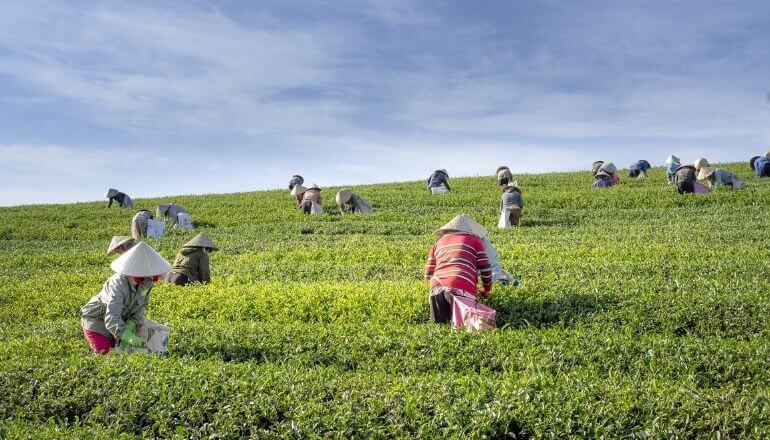
Vietnamese Green Tea [Vert Du Vietnam]
When people talk about Vietnamese tea, green tea is the first to be mentioned. For several decades, the plantations all across Vietnam, have been increasing. With the exponential growth of green tea plantations in Vietnam, it has become a symbol of Vietnamese everyday life.
Green tea plants, love the soil and climate of Vietnam and can be found in the plains but also highland areas.
This green tea can be enjoyed fresh and there is no need for oxidation. It can be enjoyed right after picking the leaves.
You prepare it, with steeping and boiling the leaves in hot water, that should never be boiling temperature! The tea needs to be served in porcelain bowls if that is possible. The guideline to brew most green teas is to brew it at temperatures between 140F – 185F.
Younger green tea leaves will benefit from a lower temperature. The same rules apply for Vietnamese tea. We have to start with warming up the porcelain bowl. The water for the Vietnamese tea has to be around 85 degrees Celsius (185 F).
For younger Vietnamese green tea leaves, we can use water from 60 Celsius (140 F) or more, up to 175 F. After a 20 second steep, it should be ready to enjoy.
There are a lot of variations of Vietnamese tea. Some of them have a very bitter aroma and others have a milder aroma. There are even variations with a sweet aftertaste.
All that, depends on the area, of the tea tree cultivations and the type of the tea plant. A lot of Vietnamese plantations are very high in the mountains and there is a lot of so-called “ancient” tea plantations, that have been preserved for generations.
Another Vietnamese tea speciality is green tea infused with Lotus flowers and it’s a true delicacy. The hard work that is put into preparing the mixture for Lotus tea, makes it very luxurious. Green tea leaves are mixed with Lotus pistils.
Taste and Aroma Of Vietnamese Green Tea
There are a lot of variations of Vietnamese tea. Some of them have a very bitter aroma and others have a milder aroma. There are even variations with a sweet aftertaste.
All that, depends on the area, of the tea tree cultivations and the type of the tea plant.
A lot of Vietnamese plantations are very high in the mountains and there is a lot of so-called “ancient” tea plantations, that have been preserved for generations.
Another Vietnamese tea speciality is green tea infused with Lotus flowers and it’s a true delicacy.
The hard work that is put into preparing the mixture for Lotus tea, makes it very luxurious. Green tea leaves are mixed with Lotus pistils.
Here is a very good example of Vert Du Vietnam Green Tea from Amazon
Time And Temp For Vietnamese Green Tea
1 Minutes
A Low steep time is recommended for Vietnamese Green Tea
60°to 85°C
The temperature varies for these green teas based on the type.
2 Teaspoons
A couple of teaspoons is plenty to get the best out of these teas.
The Finish
Vietnamese Green Tea might not be the most well know type of green tea around, but you own it to yourself to give this fantastic tea a chance. I think it will be a great addition to your green tea repetoire
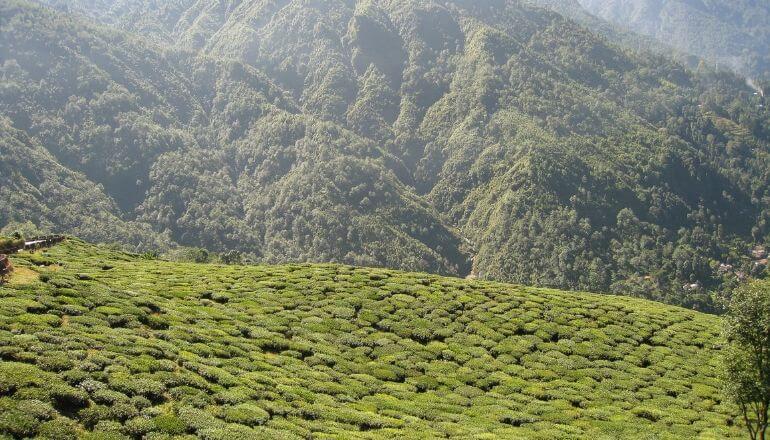
Darjeeling Green Tea
Darjeeling green tea comes from The Darjeeling region of India. India is known for is black tea production in this region, but the green tea offering is very good and quite well respected around the world.
Taste and Aroma of Darjeeling Green Tea
The taste of Darjeeling green tea is quite vegetable and has a bit of grassiness to it. It also has a bit of natural sweetness. I find it to be just as flavorful as some of the more popular and well-known Japanese and Chinese green teas.
Time And Temp
2 Minutes
A 2 minute Steep Works Well With This Green Tea Type
80°C
I Found This Temperature To Be The Best For A Great Cup
2 Teaspoons
A Couple Of Teaspoons Is All You Need TO Get That Perfect Steep
The Finish
The Darjeeling green really holds up well compared to some of the other green teas from around the world. You can find some great examples of this tea but my favorite is Vahdams Darjeeling green tea. You can find it right here at Amazon.
The Big Finish
That brings us the the end of our look at the most popular types of green tea. I will be adding to this list as I try new and interesting types of green tea.
I find that expanding my horizons when it comes to tea is one of the best way to find a new favorite tea to drink.
Part of the fun is trying new thing from new regions and learning the history of that particular green tea and how to make a perfect cup to enjoy.
Hopefully, you find something on this list that will be a new experience for you. There are plenty of remarkable green teas to consider and more to come.
Thanks for visiting and have a wonderful day.
